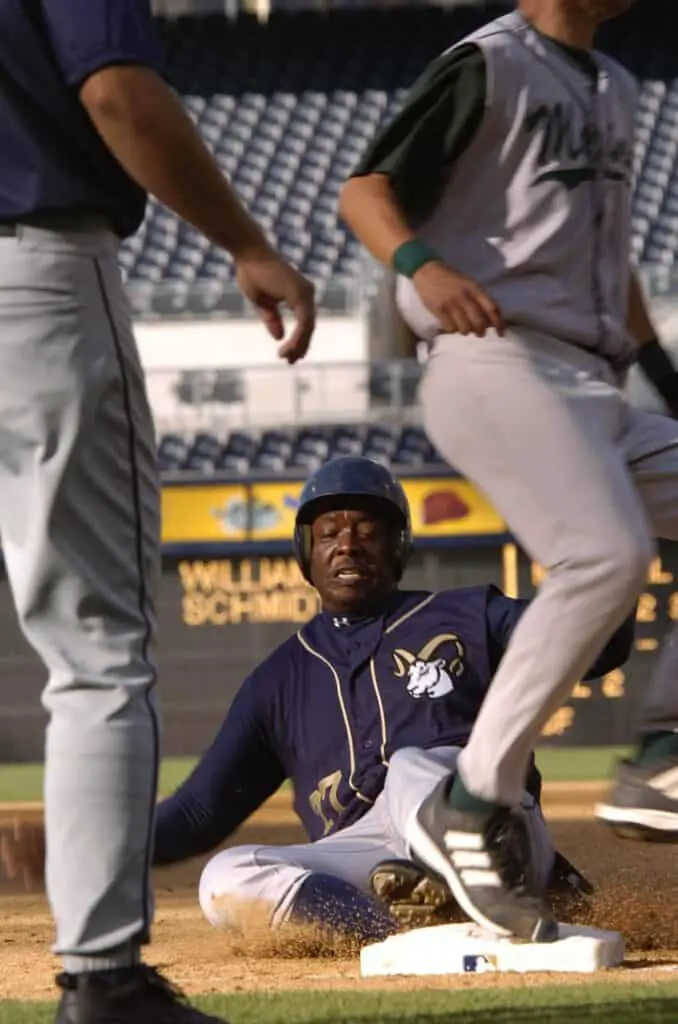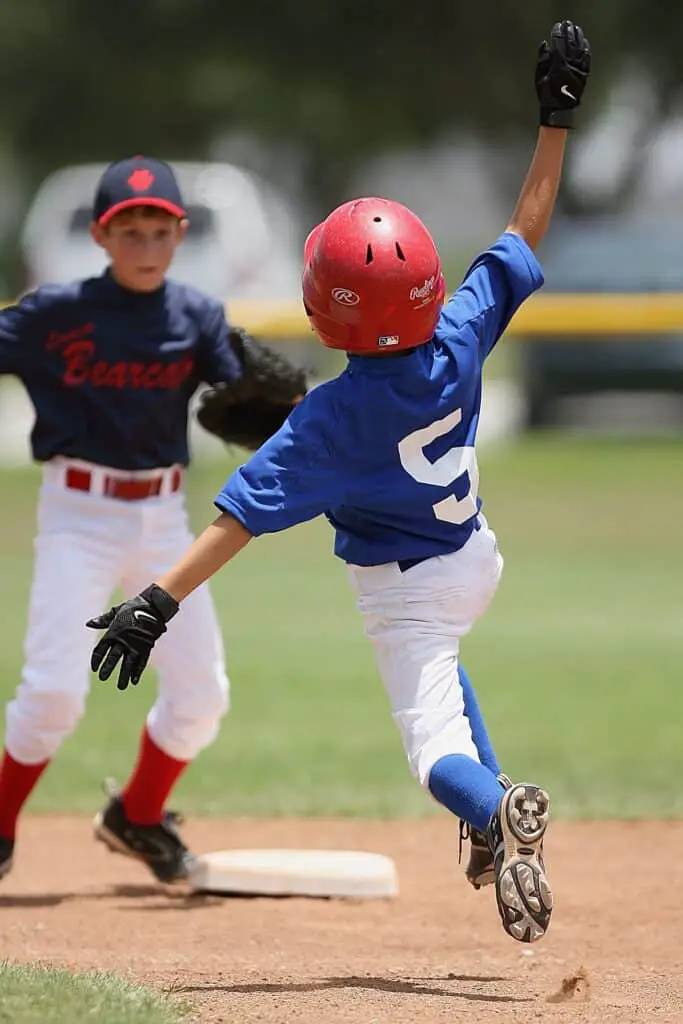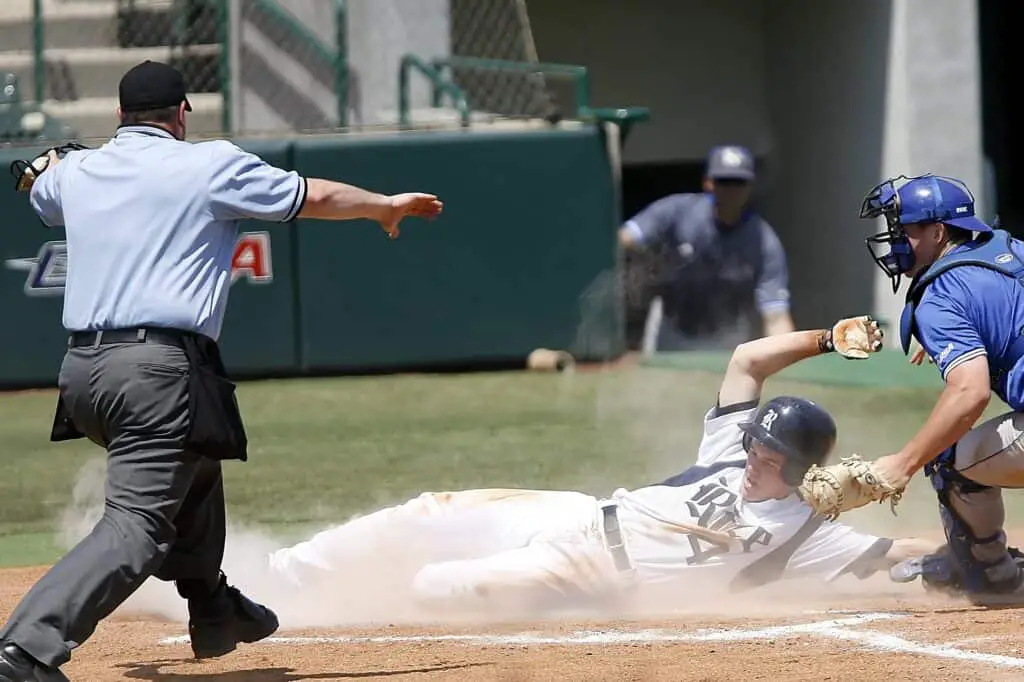In baseball, a slip is the action of a performer, getting on approximately as a baserunner, who lowers his body to the surface once he is near the ground he is pulling near and slides along the ground to arrive at the base. Sliding is broadly viewed as a basic segment of baserunning in both youth and expert baseball, however not unequivocally for a similar explanation.
Sliding enables a sprinter to stop his forward energy through the grating made between the body and the ground, along these lines lessening the probability that he will pursue past the base contacting it.
Click here to view and buy great Baseball gadgets.

Advantages of sliding for a baseball player to slide into a base?
There is a way of thinking that making a plunge is snappier than running straight through the base since you increase a full body length when you dispatch yourself headfirst toward the sack and the power of gravity adds speed to your run. On the off chance that you watch runners approach the finish of their runs, you will see that they lean forward into the tape to spare several thousandths of a second by shortening the separation that they need to run. Those players who do slide directly into the pack are simply conveying this hypothesis to the extraordinary. I don’t have the foggiest idea whether anybody has tried this hypothesis with the best possible planning gear to check whether there is anything to the hypothesis, yet it’s anything but an exceptional conviction that the quickest route to the base is to go head first.

It’s my conviction that the main time that this hypothesis may be genuine is if the player isn’t running at rapid when he dispatches his body toward the base, for example, getting back to the base on a pickoff toss. I accept that in any circumstance wherein the sprinter is running at speed any bit of leeway picked up by adding body length to his run is nullified by the way that the feet of the sprinter are fair and square of the base so their way to the base is more like a straight line than the way that the hands need to take from shoulder stature to the ground. Also, this doesn’t mull over the speed lost given contact with the earth during the slide. I accept that an appropriately executed, straight in feet first slide is in reality similarly to as speedy if the not speedier approach to beat the ball to the base when a slide is vital, for example, on a power play when the sprinter wishes to beat the ball to the base and needs to abstain from invading the sack.
The main potential gain I see to the headfirst slide is the “swim move” used to trick the protector when the ball is clearly at the base in front of the sprinter, however, in the past, most players were considerably more misleading with “blur away slides” and “snare slides” than the present players. Include the more noteworthy opportunities for injury with the headfirst slide, and I see a little bit of leeway to utilizing it aside from on pickoff plays.
Reasons for sliding
1. Staying away from a tag out
On plays in which the baserunner might be labeled out by the restricting protective player covering the base, the baserunner’s body being down on the ground presents the most reduced profile focus for the guarded player to tag. This makes it somewhat harder for the protective player to apply the tag to put out the baserunner.
2. Abstaining from overwhelming the base

Sliding enables a sprinter to stop his forward energy through the grating made between the body and the ground, hence diminishing the probability that he will pursue past the base contacting it. This is significant because by and large a sprinter is at the risk of being labeled out if he loses contact with the base (the most widely recognized exemption is that a player sprinter may invade a respectable starting point when at first arriving at that base as long as he promptly re-visitations of a respectable starting point without endeavoring to progress to a respectable halfway point). Since the sprinter must adjust the need to arrive at a base as fast as conceivable with the need to abstain from overwhelming the base, sliding gives a quick way to the sprinter to decelerate, permitting the baserunner to run at maximum velocity as far as might be feasible before expecting to back off.
3. Meddling with the protective player (take-out slide)
Sliding can in some cases be utilized as a method for meddling with the play of the restricting cautious player who is covering the base being drawn closer. For instance, when it is conceivable that a twofold play may happen, and the baserunner moving toward a respectable halfway point has just been put out, he may even now attempt to slide toward the cautious player who expects to toss the ball to initially base. If the protective player moves from a respectable halfway point as he plans to toss the ball toward first, the baserunner may at present slide legitimately toward the guarded player, even though that implies sliding endlessly from a respectable halfway point itself. This has the impact of hampering that protective player’s capacity to finish the play, either straightforwardly by connecting with him, or by implication by diverting him by making him dreadful of such contact. A slide performed solely to hamper the play of the safeguard is known as a “take-out slide”.
4. Evading crash or injury from the deviant toss
Especially for more youthful players, the legitimate sliding strategy has been appeared to shield the sprinter and defender from impacting and can keep the sprinter from being hit by a wayward toss. Hence, most youth baseball classes currently prompt encouraging legitimate sliding method at a youthful age and urge children to slide feet-first into any base (aside from a respectable starting point) at whatever point there is a possibly close play. This idea is fairly more disputable in grown-up novice baseball/softball associations since the danger of injury from sliding increments with age.

Techniques for sliding
There is a wide range of approaches to slide, including various methods of endeavoring to dodge the tag, coming to contact the base, or attempting to contact or evade crash with the cautious player. Since the safeguard by and large anticipates a slide, now and again a baserunner attempting to abstain from being labeled out won’t slide legitimately towards the base, yet rather to a side away from where the ball is coming, and afterward, reach back to contact the base.
Players by and large slide feet-first yet now and again likewise utilize a head-first strategy. Carefully, going recklessly into a base comprises to a greater extent a jump than a slide, yet the expression “slide” is still ordinarily utilized. This substitute strategy has been utilized in Major League Baseball at any rate since the center 1880s when the advancement was advocated by the St. Louis Browns of the American Association.[1] Yet even in the majors, it remained moderately remarkable until it became promoted by Pete Rose during the 1960s. Recklessly sliding has since become a typical practice for different players on all degrees of expert baseball, however, it is frequently limited on the beginner level.
One investigation in the American Journal of Sports Medicine followed seven softball and three ball clubs in Division I of the NCAA and found the general occurrence of wounds supported while sliding was 9.51 per 1000 slides. Softball players had about double the occurrence of sliding wounds as baseball major parts in the investigation. 11% (four out of 37) of the wounds made the player miss over 7 days of participation.
Since baseball shoes are spiked on the base, sliding with the spikes upbuilds the likelihood of injury to the guarded player covering the base. Information on this reality can regularly build the protective player’s dread of the conceivable contact from a looming slide and subsequently increment his interruption while endeavoring to make a play. Ty Cobb created nine unique approaches to slide into a base.
People also ask
Does sliding into a baseball ground bring you there sooner?
A executed feet-first slide ought to have the option to get a sprinter to contact a base around one-seventh of a second quicker than going through it. The sprinter contacts the base with toe pointed, hands over his head and upper leg bowed far up.
Is it against the rules to slide into first base?
Sliding is permitted, however not in any manner bases. Sprinters may slide feet first into second or third base. Sprinters may not slide into a respectable starting point or the wellbeing base at home plate. Sprinters may not slide directly into any base on the field.
Who began the headfirst slide?
Indeed, even Pete Rose, the one who made the heedlessly slide chic, says there are a period and spot to be judicious. As in, no compelling reason to get your nose slammed in at the home plate. “You would prefer not to slide carelessly into shin protectors,” said Rose, who played the most games in major alliance history.